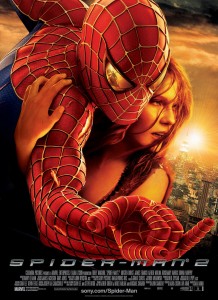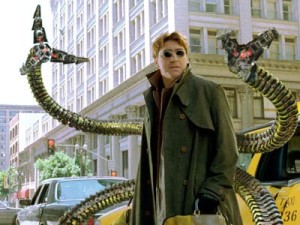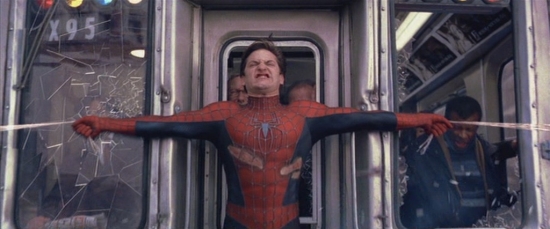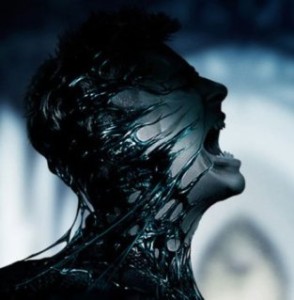In a multi-part series, Comic Book Film Editor William Gatevackes will be tracing the history of comic book movies from the earliest days of the film serials to today’s big blockbusters and beyond. Along with the history lesson, Bill will be covering some of the most prominent comic book films over the years and why they were so special. Today, we look at the highs, the lows and the grisly end of the first Spider-Man trilogy.
 With Spider-Man a resounding success, Sony’s decision to start work on the sequel before that first film came out turned into a prudent decision. Sam Raimi was back at the helm, with script by Smallville’s Alfred Gough and Miles Millar, who were later joined by David Koepp. This script would have brought Spidey into conflict with Doctor Octopus AND the Lizard AND Black Cat. See, the villain cramming started almost immediately.
With Spider-Man a resounding success, Sony’s decision to start work on the sequel before that first film came out turned into a prudent decision. Sam Raimi was back at the helm, with script by Smallville’s Alfred Gough and Miles Millar, who were later joined by David Koepp. This script would have brought Spidey into conflict with Doctor Octopus AND the Lizard AND Black Cat. See, the villain cramming started almost immediately.
Novelist Michael Chabon was tapped to rewrite the script. He pared the villains down to just Doc Ock but made him more a contemporary of Peter and had him enter a love triangle for the affections of Mary Jane. Harry’s quest for vengeance would begin in earnest, having put out a $10 million bounty on Spidey.
Raimi worked with screenwriter Alvin Sargent to cull bits and pieces from various screenplays and molded them into the formula that was used in the first film. Doc Ock was the main villain, and once again, the bad guy was a sympathetic figure who was a mentor/father figure to Peter, albeit with an air of tragedy added to the mix. Doctor Otto Octavius goes mad after an experiment to create cold fusion goes haywire, killing his wife and fusing his prosthetic arms to him.
 The formula extended to the casting as well, as talented British actor Alfred Molina was cast as Otto Octavius over bigger names that were rumored to be up for the role such as Robert DeNiro or Ed Harris. Once again, the ploy worked out because we were allowed to focus on Molina’s great acting without any baggage another actor would have brought to the role.
The formula extended to the casting as well, as talented British actor Alfred Molina was cast as Otto Octavius over bigger names that were rumored to be up for the role such as Robert DeNiro or Ed Harris. Once again, the ploy worked out because we were allowed to focus on Molina’s great acting without any baggage another actor would have brought to the role.
However, we came close to having a new Peter Parker. Tobey Maguire made some noise about not returning to the role due to back problems, which was married to some complaints he had about his salary for the first film in comparison to the money the film made. Sony/Columbia went so far as to offer the role to Jake Gyllenhaal as a replacement before calmer heads and healthy backs prevailed and Maguire rejoined the cast.
The film also took notes from the comic books as Peter has problems with his powers (as he often did in the comics) which cause him to give up being Spidey for a while (as he did in the classic Amazing Spider-Man #50, which is referenced in a shot of Peter putting his Spidey costume in the trash).
Raimi seems to come into his own here. The surgery scene is vintage Raimi slapstick horror, and the emotional beats play better here that in the original. Bruce Campbell returns, this time as a snooty Broadway theater usher who refuses Peter late entry into Mary Jane’s play.
 This all resulted in a better film than the first one, in quality if not in grosses. It broke the record for one day grosses set by the first film with $40.4 million, but its domestic take of $373.5 million and $783.7 million worldwide lagged behind its predecessor.
This all resulted in a better film than the first one, in quality if not in grosses. It broke the record for one day grosses set by the first film with $40.4 million, but its domestic take of $373.5 million and $783.7 million worldwide lagged behind its predecessor.
But that haul was still worthy of garnering a sequel, and garner a sequel it did. And it was now that the wheels came off the franchise.
 Once again, development of the film began before the prior film had even hit theaters, and almost immediately the production got off on the wrong foot. Raimi (along with a returning Sargent) was interested in bringing two villains, the Sandman and the Vulture, into the film to fight Spidey. As any experienced comic book film viewer can tell you, once you add more than one villain to the mix, you’re asking for trouble.
Once again, development of the film began before the prior film had even hit theaters, and almost immediately the production got off on the wrong foot. Raimi (along with a returning Sargent) was interested in bringing two villains, the Sandman and the Vulture, into the film to fight Spidey. As any experienced comic book film viewer can tell you, once you add more than one villain to the mix, you’re asking for trouble.
Worse than that, Raimi intended the Sandman to be a petty thief named Flint Marko, a man who steals to help his sick daughter, that got himself trapped in a particle accelerator and had his body fused with sand. Since this didn’t have the emotional pull it needed, Raimi decided to do a retcon and have Marko be the man who really killed Uncle Ben, albeit quasi-accidentally. This plot point is what irritated me the most about this installment. It was tacked on and it completely felt like it was. It was a cheap way to ramp up the emotional through lines of the film.
 Then Avi Arad got involved and convinced Raimi to change the Vulture to the more modern and more popular comic book villain Venom. Venom’s origin in the comic books is way too convoluted (it was an alien symbiote that Spider-Man picked up on an alien planet that he used as a costume until he found out it was sucking the life force out of him and he had to get rid of it. The symbiote then bonded with Eddie Brock, a man with an intense hatred of Spider-Man) so they simplified it for the film, slightly (it was an alien symbiote that came to Earth attached to a meteor that landed in Central Park, near where Peter was having a romantic rendezvous with Mary Jane. The symbiote managed to attach itself to Peter’s moped and followed him home, where it eventually became Spider-Man’s costume and began to negatively change his personality. Peter got rid of it and it attached itself to rival photographer Eddie Brock). Nonetheless, the character was a turn away from the “science gone wrong” villains the franchise had to that point.
Then Avi Arad got involved and convinced Raimi to change the Vulture to the more modern and more popular comic book villain Venom. Venom’s origin in the comic books is way too convoluted (it was an alien symbiote that Spider-Man picked up on an alien planet that he used as a costume until he found out it was sucking the life force out of him and he had to get rid of it. The symbiote then bonded with Eddie Brock, a man with an intense hatred of Spider-Man) so they simplified it for the film, slightly (it was an alien symbiote that came to Earth attached to a meteor that landed in Central Park, near where Peter was having a romantic rendezvous with Mary Jane. The symbiote managed to attach itself to Peter’s moped and followed him home, where it eventually became Spider-Man’s costume and began to negatively change his personality. Peter got rid of it and it attached itself to rival photographer Eddie Brock). Nonetheless, the character was a turn away from the “science gone wrong” villains the franchise had to that point.
 You can almost see Raimi’s dislike of being forced to take Venom on in the casting for the villains roles. For Sandman, he cast Thomas Hayden Church, who was fresh off his Oscar nomination for Sideways, who brough weight and pathos to the role. For Venom, he cast Topher Grace, an actor with plenty of Teen Choice Award nominations to his credit, who seemed overwhelmed by the role, relying on smarmy and snark to get him by.
You can almost see Raimi’s dislike of being forced to take Venom on in the casting for the villains roles. For Sandman, he cast Thomas Hayden Church, who was fresh off his Oscar nomination for Sideways, who brough weight and pathos to the role. For Venom, he cast Topher Grace, an actor with plenty of Teen Choice Award nominations to his credit, who seemed overwhelmed by the role, relying on smarmy and snark to get him by.
The producers also wanted to introduce Gwen Stacy (played by a redhead turned blonde Bryce Taylor Howard) into the mix to create a love triangle with MJ (still played by the blonde turned redhead Kirsten Dunst) for Peter’s affections. Harry also formed the corner of another love triangle for MJ’s affections, meaning the film had two competing love triangles, neither of which was as well formed or as well developed as one would have liked.
 Speaking of Harry, it was in this film that they decided to bring his long simmering quest for vengeance to the forefront, creating yet another villain for Spidey to fight as Harry donned updated versions of his father’s Goblin gear. Harry’s character arc goes from villain to supporting character (after he gets amnesia (?)) to villain to hero, without ever doing the due diligence the changes deserve.
Speaking of Harry, it was in this film that they decided to bring his long simmering quest for vengeance to the forefront, creating yet another villain for Spidey to fight as Harry donned updated versions of his father’s Goblin gear. Harry’s character arc goes from villain to supporting character (after he gets amnesia (?)) to villain to hero, without ever doing the due diligence the changes deserve.
Bruce Campbell makes his final cameo, this time as a maître d’ who helps Peter try to propose to Mary Jane.
All of this adds up to a jam packed, convoluted film that, in all honesty, isn’t quite as bad as everyone makes it out to be. Sure, compared to the two films that came before it, it was Plan 9 from Outer Space-bad. But compared to Catwoman or Ghost Rider? Miles above those two.
Even though many critics considered the film to be the worst of the lot, moviegoers didn’t think so. They made the film the highest grossing one of the trilogy, earning $890,871,626 worldwide. So, yet another sequel was in the making. Raimi, Maguire and Dunst all agreed to return for the fourth installment.
But it was not to be. We’ll talk about that next time, along with the reboot that took its place.





HISTORY OF THE COMIC BOOK FILM: Spidey’s Rise And Fall http://t.co/90ZAKN6U9m